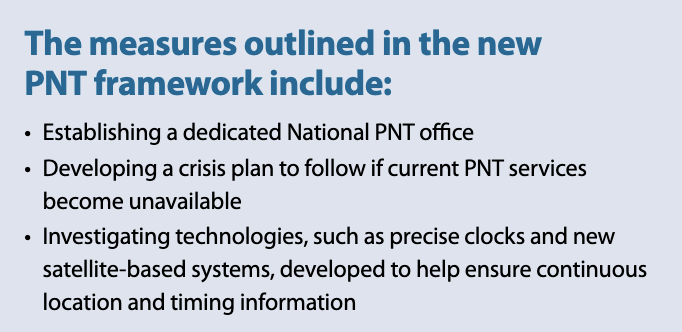There has never been a clearer and more widespread acknowledgement of PNT vulnerability. With its new strategy for ensuring the continuity of positioning, navigation and timing (PNT) services, the United Kingdom adds considerable impetus to a trend that has already witnessed new determination on the parts of the United States and the European Union to assess real, alternative PNT (A-PNT) and/or complimentary PNT (CPNT) solutions.
For years, bodies such as the UK’s Royal Institute of Navigation have rightly and repeatedly reminded the world of the limits and vulnerabilities of GNSS-based PNT technologies. As long ago as 2014, we reported on the venerable Bradly ‘father of GPS’ Parkinson’s call to “protect, toughen and augment” GNSS. Today, military conflicts highlight on a daily basis both the importance and vulnerability of GNSS, with hostile parties using powerful jamming techniques to disrupt adversaries’ vital GNSS-based PNT capabilities. Further, recent aggressive actions in space, notably by Russia, have underlined the defenselessness of many space-based PNT assets.
New Strategy Announced
Measures under the new UK strategy for ensuring the continuity of PNT services include the elaboration of a comprehensive crisis plan, to be activated should PNT services become unavailable. This cross-government plan is to be regularly updated, and will include measures for, among other things, identification and implementation of short-term mitigation actions.
The UK will also develop a proposal for a National Timing Centre, to provide resilient, terrestrial, sovereign, and high-quality timing for the UK. Precise time and synchronization are the often overlooked components of PNT, crucial for a range of strategic activities, including in telecommunications and computer networks, energy generation and distribution, and finance.
The UK also intends to develop a UK SBAS (satellite-based augmentation system), equivalent to the U.S. WAAS and EU EGNOS systems. The new UK SBAS will replace the UK’s use of EGNOS, monitoring GNSS and enabling GNSS-dependent, high-accuracy positioning for autonomous applications and other precision uses.
The UK strategy also includes development of a PNT growth policy, including R&D programs, a standards and testing activities. The new policy will be geared to drive maximum innovation for maximum PNT-based productivity.
The UK government has already published a new research report showing the economic impact on the UK if GNSS is disrupted. The report examines seven priority sectors, including: agriculture; aviation; emergency services; finance; and maritime, rail and road transport. It finds that a 24-hour GNSS outage could result in a £1.4 billion loss to the UK economy, while a 7-day outage would cost the economy £7.6 billion. These figures alone would seem to provide ample justification for the new framework.

The EU JRC and the U.S. Department of Transport
The new UK CPNT framework is particularly interesting in the context of recent Joint Research Centre (JRC) and U.S. Department of Transport (DOT) activities. Earlier in 2023, the JRC of the European Commission completed an in-depth performance assessment involving selected A-PNT providers, who showed off a variety of platforms providing precise PNT without the use of navigation satellites. The campaign was carried out mainly in Ispra, Italy, with four companies, OPNT, 7 Solutions SL, SCPTime and GMV demonstrating timing services, and three others, Locata, Satelles and NextNav, demonstrating both timing and positioning services.
Among the JRC’s general conclusions was there are demonstrably viable alternatives to GNSS for PNT applications today. The publication of the JRC conclusions have stimulated new and positive interest in A-PNT technologies throughout the EU and the world.
Across the Atlantic, the DOT issued a CPNT Action Plan in 2023, comprising a comprehensive roadmap to ensure the safety, security and efficiency of critical infrastructure in the face of potential GPS disruptions. Like the EU did with its JRC initiative, the DOT plan will establish field trials and other test campaigns to evaluate the performance and resilience of domain-specific CPNT technologies.
Importantly, the DOT also plans to act as the U.S. government’s lead adopter and purchaser of PNT services, to accelerate testing and market development in the private sector.
Not a One-Off
The new UK CPNT framework also builds on previous UK government work on PNT, including the 2018 Blackett Report, and the work of the UK Space Agency’s Space Based PNT Program. In 2021, the UK government, in its Integrated Review of Security, Defense, Development and Foreign Policy, committed itself to strengthen the resilience of PNT services. It also included the loss of PNT services in its 2023 National Risk Register, which represents the government’s assessment of the most serious risks facing the UK.
The new CPNT strategy is also being considered against the backdrop of the UK’s 2020 exit from the EU, referred to in 2022 by ESA Navigation Director Javier Benedicto as a great loss to the European Union. No longer able to fully leverage the EU’s collective and ongoing experience and achievements in GNSS and other PNT technologies, the UK is clearly intent on making its own way, independently, while yet contributing to a wider movement toward more resilient, less vulnerable, non-GNSS-based PNT.
For more details on the JRC Report, read “Backing Up GNSS“.






